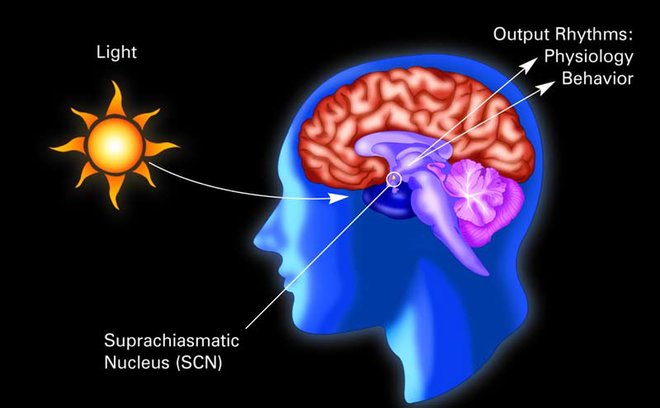Why are we awake during the day and sleep at night? Why do you feel more tired as the day progresses? There are two major process involved in regulating the sleep-wake system.
Circadian Rhythm (Biological Clock)

The circadian rhythm uses environmental signals to create a corresponding internal daily rhythm. Circadian process (including sleep, feeding, temperature, and activity patterns) are primarily controlled in the brain by the suprachiasmatic nucleus, a small region within the hypothalamus (Sleep Disorders and Sleep Deprivation: An Unmet Public Health Problem., 2006). The main environmental driver of the circadian rhythm is the change in light, since this generally reflects the time of day. Light enters the eye and reaches the retina, which then transmits the light signal to suprachiasmatic nucleus (SCN). The SCN then coordinates the daily cycles of sleep, feeding, activity, and corticosteroid hormone secretion. Exposure to light in the mornings cues the suprachiasmatic nucleus to send signals to increase the body’s temperature and inhibit melatonin- processes that help you wake up. When it gets dark, the suprachiasmatic nucleus decreases core body temperature and instructs the pineal gland to secrete melatonin, a hormone which helps further regulate the circadian rhythm. Lightness and darkness are so important to the circadian rhythm that being exposed to even a small amount of light during the night can suppress melatonin secretion and increase body temperature.
Artificial lighting and electronic devices are new advances in our evolutionary history and our bodies have not yet been able to adapt. Light is composed of many different wavelengths, which are each associated with a particular color. Blue light (which is found in high concentrations in our electronics) adversely affects production of the sleep producing hormone melatonin more than any other wavelength. By keeping indoor lighting dim at night, wearing blue light blocking glasses at night, using an app like f.lux on computers and tablets, and avoiding looking at electronic screens 2 hours before bedtime, you can combat the adverse effects of blue light at night.
Sleep Homeostasis

Another important biological component of sleep is homeostasis. Homeostasis is generally defined as a collection of processes for an organism to maintain a stable internal environment. When optimal conditions are changed, homeostatic regulatory mechanisms kick in to maintain a balanced equilibrium. Sleeping is a compensatory response to the preceding waking episode. The longer you have been awake, the stronger the drive to fall asleep (Vyazovskiy et al., 2017). Once you fall asleep, the pressure to sleep begins to dissipate until eventually you are likely to wake up. During a waking episode, glycogen (one of the body’s energy sources) is depleted and adenosine (a sleep-regulating neuromodulator) is accumulated in the forebrain, which inhibits the reticular activating system (the part of the brain that keeps you awake). By inhibiting the reticular activating system, the build up of adenosine makes you feel more sleepy (Schwartz and Roth, 2008). In general, the pressure is specific to non-REM sleep (otherwise known as “deep” sleep). After an adequate night containing non-REM sleep, adenosine is removed and you will awaken feeling ready to begin the new day.
Top image credit: Credit: National Institute of General Medical Sciences
